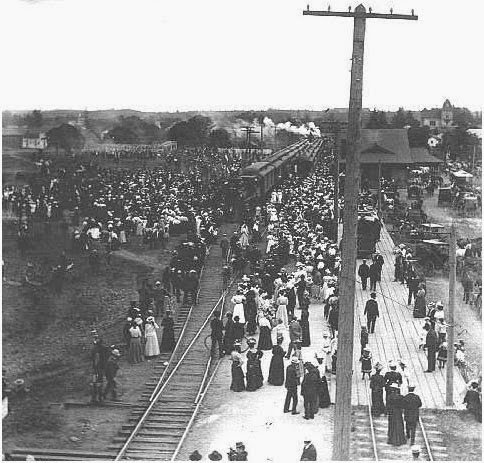World Events
- Russia increases control over Finland, declaring the right to veto their legislative rulings.
- U. S. takes possession of Wake Island. Philippine people demand independence and hostilities begin in Manilla. The war will continue until 1902.
- The Hague Convention establishes the first multinational treaties addressing the conduct of the military forces toward defeated opponents and the protection of civilians caught up in combat. These treaties are based on the Lieber Code signed by Abraham Lincoln during the Civil War.
- The Great Blizzard brings freezing temperatures as far south as Florida, bringing disaster to the Florida citrus crop.
- Marconi successful send a radio signal across the English Channel.
- Voting machines are approved by Congress for U. S. federal elections.
- Scott Joplin’s “Maple Leaf Rag” is copyrighted as ragtime music becomes popular.
- The Story of Little Black Sambo, by Scottish author and illustrator Helen Bannerman, is published as one of a series in The Dumpy Books for Children. This was the first story to portray black heroes in children’s literature. It has undergone criticism of racism since the mid-20th century.
In Salem
This photograph from Ed Austin’s collection was displayed as a part of the 1995 Railroads in Salem exhibit in the Heritage Room at the Salem Public Library. It shows a large crowd has gathered at the Salem station on August 10, 1899 to welcome the returning Oregon 2nd Volunteers home from the Spanish American War. The view, taken from the water tower (now Mission Mill Museum property), gives an interesting perspective of the early Salem layout south of this location. Note the street car to the right and the stub switch on the mainline in the foreground. A band was on hand to lead the parade downtown where table were spread for a welcome home luncheon.
When you visit
Unfortunately, we are not able to perch at the top of the water tower (which is still there) and take a comparative photograph in 2010. However, we can pick out some urban developments since that day. The area to the left was later occupied by a hop warehouse, and then the California Packing Company cannery. After the cannery closed, the Tokyo International University campus was built in that area. The station burned and was replaced by 1918 by the third railroad station, the one we use presently. The old freight depot (out of sight beyond the passenger station) survived again and is part of the Salem Railroad Station’s listing on the National Register of Historic Places.
Other Events
- This year Greenbaum’s Department Store opened at 240 Commercial Street. Now Greenbaum’s Quilted Forest, it celebrated a 100th anniversary in 1999. It is located in the remaining section of the 1889 South Eldridge Block. In 1919 the local merchants partnership of Rostein & Greenbaum bought the building. In the second Greenbaum generation, Adolph continued the enterprise, changing it to “Greenbaum’s Fine Fabrics” in the 1940s when the building was sold. When Adolph died in 1960, his sister, Irene Depenbrock, took over the business. She was responsible for purchasing the building in 1966 and so preserving it for the future of the business. Her daughter and son-in-law, Sylvia and Bill Dorney continued this family business into the present commercial life of our historic downtown.
- Maud Hill, who had walked from Missouri to Oregon as a child, marries John Zackary, the great-grandson of the noted pioneer, Tabitha Brown, often called the “Mother of Oregon.” When the marriage ended with the death of her husband in 1917, Maud made a home for her family on Front Street, laboring as a laundress to raise her five children. She died in 1954 and is remembered with honor by her descendants.
- In 1899 Steusloff Meats has a prominent downtown location at 284 Commercial and an impressive display in the interior. However, just five years later, in 1904, a new concrete building was completed for the business at 399 Court Street. In 1947-8, the exterior of the building was altered and then sold by the Steusloff family. It housed the popular “Sally’s”, a ladies’ clothing store for several years. A Starbuck’s coffee shop now occupies this northwest corner of Court and Liberty Streets.
This change in Salem’s downtown architectural style was also reflected modifications of the Pearce and Breyman buildings one block to the west at the Commercial and Court Street intersection. Nearly all modernization efforts involved the removal of decorative detail, resurfacing of the exterior facade, and updating of the ground-level storefronts. These changes reflect the evolving, post-war feeling that becoming “modern” in Salem’s commercial district would bring economic prosperity and dynamic growth.
A June ad in the Capitol Journal advised readers to stop smoking. No-To-Bac, it reported, removes the desire for tobacco without nervous distress, expels nicotine, purifies the blood, restores lost manhood, and makes you strong in health, nerve and pocketbook.
Local businesses made the news:


One Comment